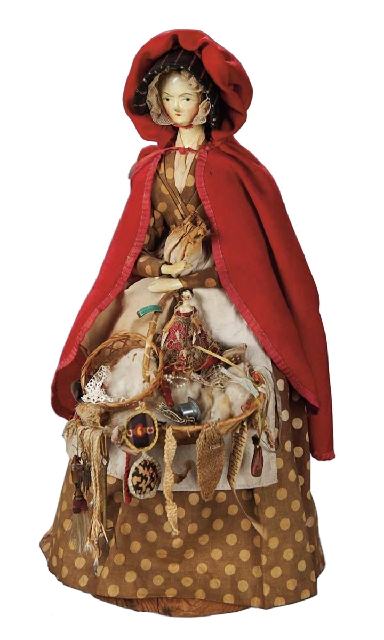Collectors seek out skillfully carved wooden dolls
Wooden dolls date back centuries. The earliest were crude carved pieces of wood shaped like a human figure. But today it’s rare to find a doll made before the 1600s, when English and German draftsmen skillfully carved wooden lifelike dolls.
Most collectors today look for later carved “peg wooden” dolls like those made in Grodnertal, Germany. The dolls, which date from about 1820 to 1840, were created with arms and legs that could bend because of their pegged joints at the knees and hips, elbows and shoulders. The early ones have heart-shaped faces, long necks and elongated bodies. Their extra-long legs showed off their high-waisted Empire-style dresses.
After the 1840s, doll carvers took shortcuts and the dolls had round faces and chunky bodies.
A 2012 Theriault’s auction offered a Grodnertal peddler doll. The 13-inch doll had her original painted face, human hair wig and jointed arms and legs. Her value increased because she wore her original clothes, from dress to cap, cape and undergarments. She was holding a peddler’s tray filled with lace, sewing materials, household goods and a tiny miniature Grodnertal wooden doll. Because she was old, attractive and in good original condition, a collector paid more than $2,900 to take her home.
Q: I have a pasteboard dollhouse designed and made by Transogram Co. of New York. It’s in reasonable shape. I think it’s from the 1920s or ’30s. It’s a two-story house with a front that opens up and a removable roof. The lower level is red brick and the second floor has yellow siding. The furniture inside is wooden and is definitely ’20s and ’30s vintage. Does the furnished dollhouse have any value, or should I just pitch it?
A: Don’t pitch it. Transogram Co. was founded by Charles S. Raizen in 1915. It made toys, play sets, games, craft sets and juvenile and playroom furniture. Raizen died in 1967, and the company was run by his family until it was sold in 1969. It closed shortly afterward.
Old dollhouses, even cardboard houses, sell to collectors. A little wear is OK.
Q: I have a dining room chair that’s blond wood with a green plastic seat. It has a latticelike back. The back legs are one piece going from the floor to the top of the back. The bottom is marked “Daystrom Furniture, Model 455-175.” The words “Made in Occupied Japan” are written in a small circle. It’s not in perfect shape. Can you tell me what it’s worth?
A: Daystrom was founded in Olean, N.Y., in 1934. At first the company made metal ashtrays. By 1938 it was producing chromium kitchen furniture and upholstered stools and chairs. Daystrom moved to South Boston in 1962 and began using the name “Daystrom Furniture.”
Daystrom’s low-end dinette sets sold well during the 1960s, but foreign competition began affecting the furniture market by the 1970s. The company was sold several times and closed in 1996.
Since your chair is marked “Made in Occupied Japan,” Daystrom must have been making furniture in a Japanese factory or importing pieces between 1947 and 1952, years when the Allies occupied Japan after World War II. Chairs like yours were inexpensive when made. Value today: about $100 to $150.
Q: In going through some old family papers, I ran across a souvenir program from a concert by Tommy Dorsey and his Orchestra at the Grand Ballroom in Pleasure Beach Park in Bridgeport, Conn., on June 1, 1941. The program includes autographed photos of Dorsey, Frank Sinatra and Buddy Rich. My father was at the concert and saw them sign their pictures. Is there any value to the program and the autographs?
A: Frank Sinatra (1915-1998) signed with Tommy Dorsey in 1939 and appeared as a singer with the band from 1940 until late 1942. Souvenir programs don’t ordinarily sell for more than a few dollars, but because yours includes an early Frank Sinatra autograph, it’s worth more. You should contact an auction house that specializes in autographs if you’re interested in selling. It could be worth more than $200.
Q: I have a complete collection of small metal license plates. They’re all about 3-by-5½ inches. I think they came from Wheaties cereal boxes. They are about 60 years old. Can you tell me if there is a demand for these and if they have any value?
A: Wheaties first offered miniature auto license plates from all 48 states and the District of Columbia in 1953. Four different sets of 12 plates each could be ordered by sending in 25 cents and a Wheaties box top. The District of Columbia plate was available in random boxes of Wheaties.
It was a very successful promotion and increased Wheaties sales. Many boys and girls sent for the license plates and attached them to their bicycles. Post Cereals issued plate sets in 1968 and 1982.
Single plates sell for about $5 today. A set of 49 plates issued in 1953-’54, with original mailers, sold several years ago for more than $600.
CURRENT PRICES
Current prices are recorded from antiques shows, flea markets, sales and auctions throughout the United States. Prices vary in different locations because of local economic conditions.
Adams platter, Empress pattern, white, oval, 8 sides, 11¾-by-8 5/8 inches, $15.
Pepsi-Cola straws, “Have a Pepsi,” stripes, bottle cap, full box, 1950s, 10¾-by-3 7/8 inches, $100.
Weller Pottery bowl, molded, flowers, birds, nest, eggs, green leaf ground, stamped, c. 1910, 3½-by-15¾ inches, $235.
Carving set, sterling silver, Rheims pattern, knife with steel blade, fork, Wallace, 1919 patent, $240.
Bamboo stand, lacquer, domed back, cupboard, shelves, stretcher, splay feet, c. 1900, 44-by-18 inches, $245.
Opaline glass vase, Napoleon III, trumpet top, inverted foot, Greek key border, gilt swags, c. 1865, 15½ inches, $370.
Berry bucket, wooden, green paint, c. 1855, 5¾-by-7 inches, $425.
Hall lantern, gilt bronze, Gothic Revival, trefoil piercings, fretwork, crenellated edge, chains, c. 1885, 31 inches, $920.
Stickley Bros. drink stand, copper top, arched apron, splayed legs, 18-by-28 inches, $2,625.
Billiards sign, leaded glass, red and green, white ground, 82¾-by-15½ inches, $3,630.
Terry Kovel’s column is syndicated by King Features. Write to: Kovels, (Las Vegas Review-Journal), King Features Syndicate, 300 W. 57th St., New York, NY 10019.
























